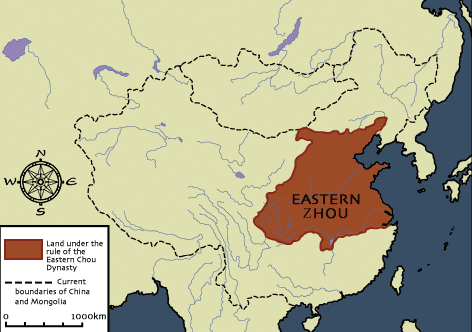Chinese Culture >> Chinese Dynasty >> Eastern Zhou Dynasty
Eastern Zhou Dynasty Background (Year: 771 - 221 BC)
 After the capital was sacked by barbarians from the west,
the Zhou Dynasty moved east, thus neatly dividing the Zhou Dynasty into eastern
Zhou Dynasty and western Zhou Dynasty
periods. As might be expected, the power of the Zhou Dynasty declined somewhat.
The so-called Spring & Autumn period, named after a book (The Spring and Autumn
Annals) that provides a history of period saw a proliferation of new ideas and
philosophies. The three most important, from a historical standpoint, were
Daoism, Confucianism, and Legalism.
After the capital was sacked by barbarians from the west,
the Zhou Dynasty moved east, thus neatly dividing the Zhou Dynasty into eastern
Zhou Dynasty and western Zhou Dynasty
periods. As might be expected, the power of the Zhou Dynasty declined somewhat.
The so-called Spring & Autumn period, named after a book (The Spring and Autumn
Annals) that provides a history of period saw a proliferation of new ideas and
philosophies. The three most important, from a historical standpoint, were
Daoism, Confucianism, and Legalism.

Daoism is a can be a very frustrating philosophy to study. It is based on study of the Dao, literally translated, "the Way." For starters, the oldest great book of Daoism, the Dao de Jing, The Way and Virtue, was allegedly written by a man named Lao-zi. However, we don't know 1) if Lao-zi was his real name, 2) if Lao-zi ever actually existed, and 3) if the book is even the work of one author. Then there are the texts themselves. The first line of the Dao de Jing can be translated as "The Way that can be walked is not the enduring and unchanging Way." It can also be translated as "The Way that can be known is not the true Way," as well as several other translations that, while all having the same general paradoxical meaning, are all different. It is also full of other cryptic and paradoxical sayings, like "The more the sage expends for others, the more does he possess of his own; the more he gives to others, the more does he have himself." Daoists loved this kind of stuff; the story about the man dreaming he was a butterfly, then waking up and wondering if he was a man or a butterfly dreaming about being a man is classic Daoism. Daoism profoundly influenced the later development of Cha'an (also known as Zen) Buddhism.
AdvertisementConfucius, who lived about five hundred years before Christ, basically believed that moral men make good rulers and that virtue is one of the most important properties that an official can have. He also believed that virtue can be attained by following the proper way of behaving, and thus placed a great deal of stress on proper. Most of what is considered 'Confucianism' was actually written down by a disciple named Mencius, who also believed that all men were basically good. Confucius also codified the status of the ruler in Chinese political thought; the Emperor was the Son of Heaven (while Heaven in a Western context is a place, Heaven in the Chinese context is a divine/natural force) and had the Mandate of Heaven to rule.
Legalism derived from the teachings of another one of Confucius' disciples, a man named Xun-zi. Xun-zi believed that, for the most part, man would look out for himself first and was therefore basically evil (remember, this is more than two thousand years before Adam Smith argued that self-interest is what makes markets work and is therefore good). Consequently, the Legalists designed a series of draconian laws that would make a nation easier to control. The fundamental aim of both Confucianism and Legalism was the re-unification of a then divided China, but they took difference approaches. Confucianism depended on virtue and natural order; Legalism used a iron fist. Legalism has been called "super-Machiavellian;" this is not unwarranted, as it called for the suppression of dissent by the burning of books and burying dissidents alive (maltreatment of the opposition is nothing new in China; because the system starts with the idea that the Emperor is the Son of Heaven and has the Mandate of Heaven to rule, there is no such thing as legitimate dissent and thus no concept of "loyal opposition"). Legalism advocated techniques such as maintaining an active secret police, encouraging neighbors to inform on each other, and the creation of a general atmosphere of fear. In fact, many of the same tactics that the Legalists approved of were later employed by Hitler, Stalin, and Mao.
The politics of the Warring States period were much the same as those of the Spring & Autumn period; the major difference was that while in the earlier period, armies were small and battles lasted only a day, much like in pre-Napoleonic wars, the later period featured what modern strategists would call "totalwar." Massive armies (half a million per army was not an uncommon figure), long battles, sieges, were all common features of the Warring States battlefield.
Click on pictures below to enlarge.
Chinese Dynasty Quick Links
Tang Dynasty Xia DynastyWestern Zhou Dynasty Eastern Zhou Dynasty Shang Dynasty Qin Dynasty Han Dynasty Three Kingdom Dynasty Sui Dynasty Song Dynasty Yuan Dynasty Ming Dynasty Qing Dynasty Early 20th Century China


